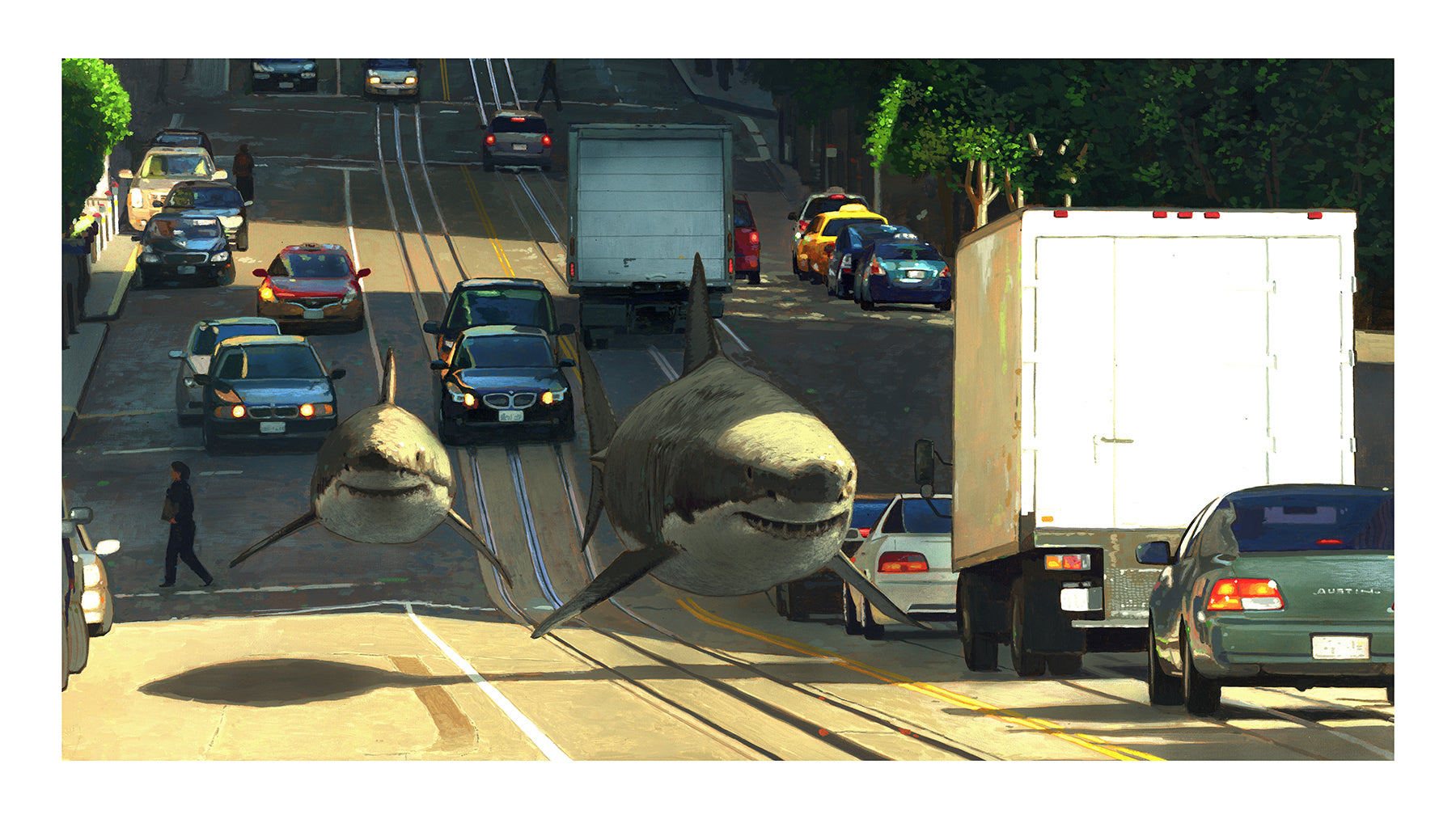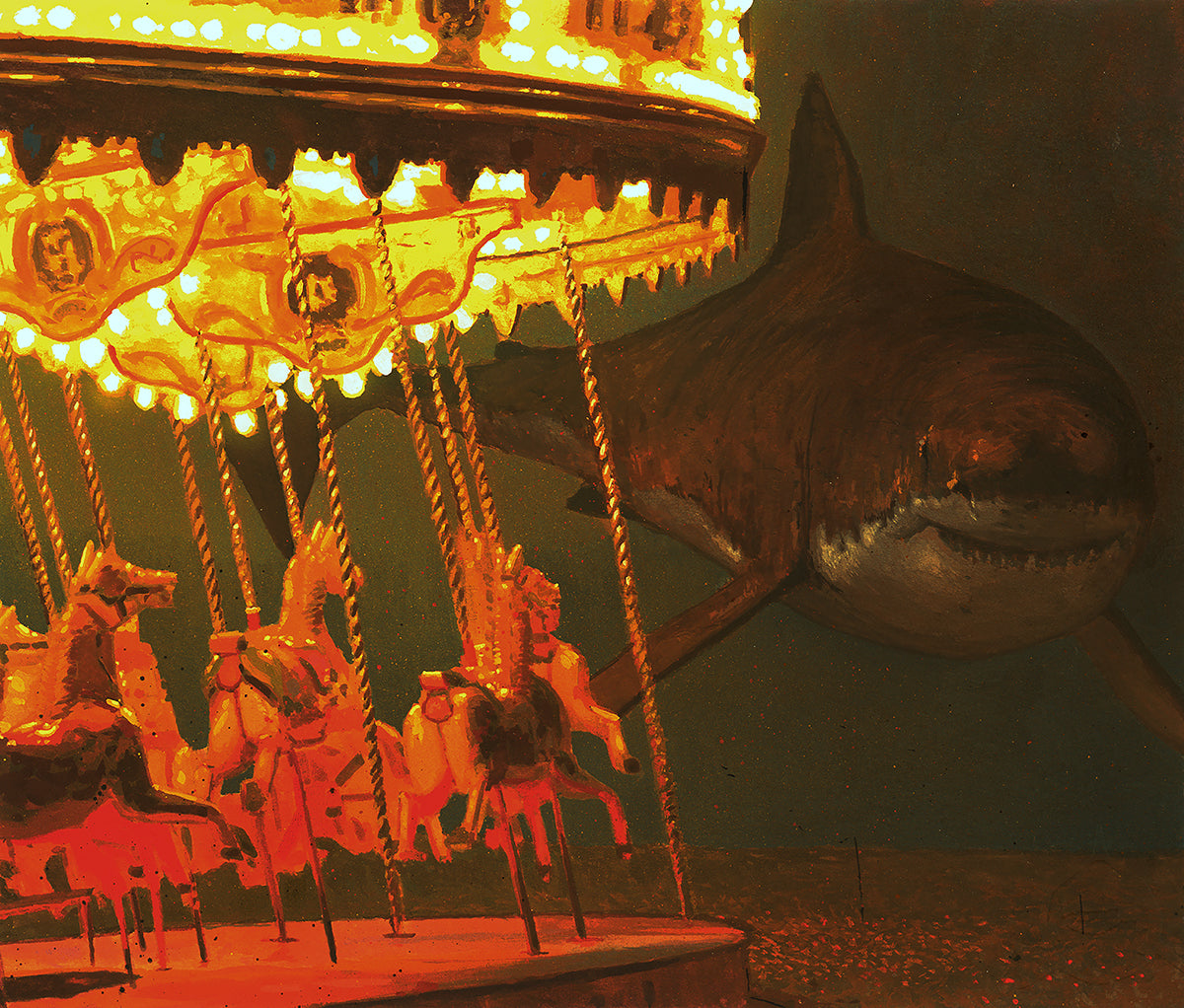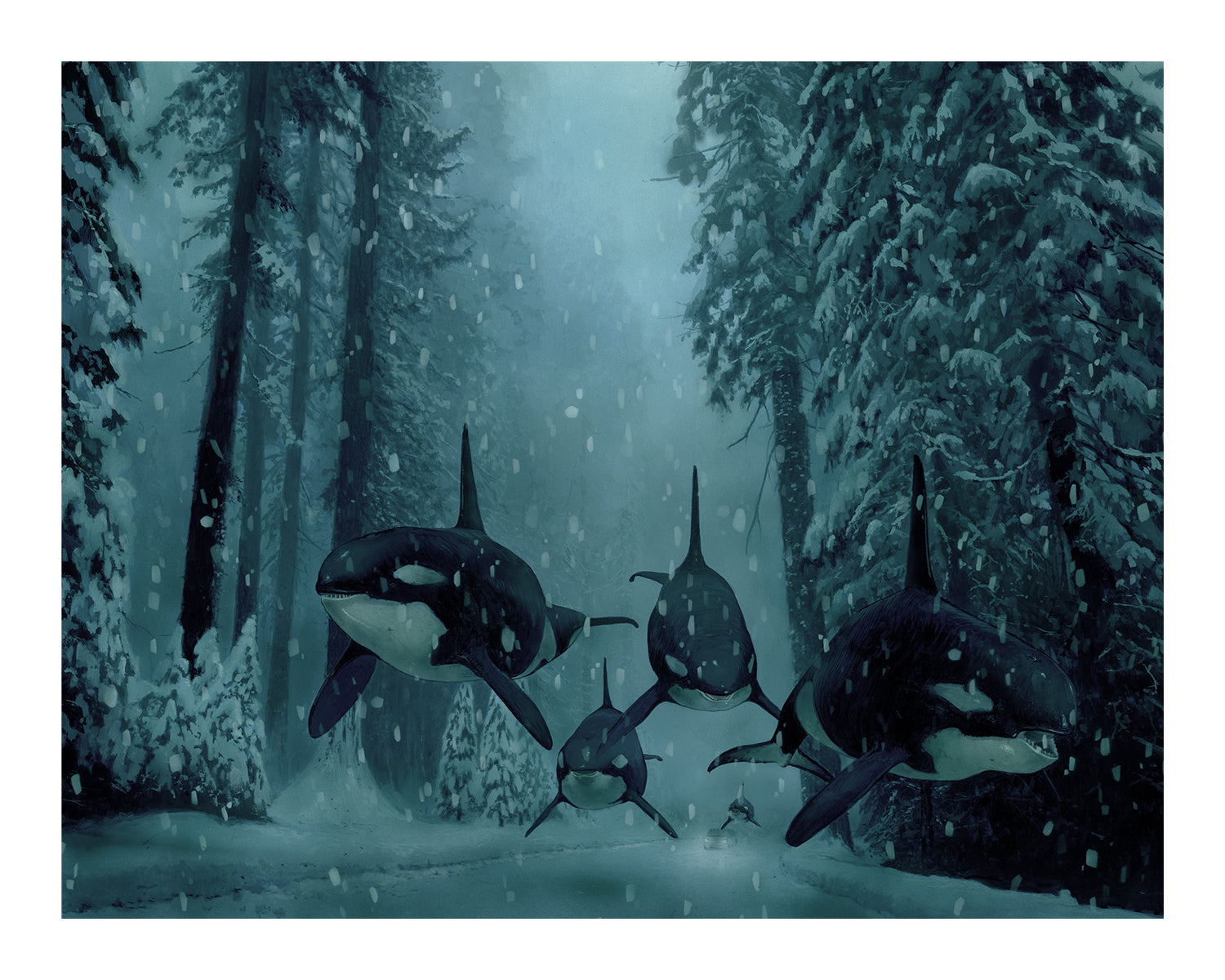
Kit King is one of the world's leading young hyperrealist artists who's devotion to detail in her imaginative dreamscapes, which often feature the human body and are completed in collaboration with her husband Oda, are achieved through an ultra-focused technical ability conjured from abstract processes and experimentation. The results are readily astounding and often haunting.
In anticipation of this Thursday's release with The People's Printshop, I sat down to ask Kit a few questions about life, art and Stranger Things. Take a look:
You grew up in an artistic household, I did as well. Looking back at it now I realize that my life was completely different and independent from every person I grew up around. Do you have this same feeling or realization? What were some highlights of growing up this way?
Oh, I most certainly led a very different life than those around me. My family is completely kooky. We're a bizarre bunch. What was normal for me/us, I came to realize wasn't normal for everyone else. This led to me becoming somewhat of an outcast - which of course fuels the artistic flames for me. I spent a great deal of time alone and this solitude was predominantly spent creating. Art has pretty much always been the highlight of my life.
You were never trained formally in school, what were some jobs you pursued or held before going into art full time? Or has it always been just art for you?
I've actually never had a "real job.” I was a cashier at a coffee joint for two months when I was 15 before I quit. After that I started making my living off of art. I'd sell my work as tattoo designs out of my locker in high-school once my peers expressed interest and started making requests when they'd see my binder doodles. I would do face painting at parties and events (which was made better by the free cake). Then I became a tattooer at eighteen. I tattooed for seven years, which during that time I'd sell drawings and paintings whenever I could find some down time between appointments. Near the end of my tattoo career I developed some anxiety issues, which ultimately led to me having to give up tattooing as I could no longer be around people or leave my home without having severe panic attacks. It turned out to be a blessing in disguise. I never sought out becoming a tattooer, but rather, fell into it and ran with it since it allowed me to be creative. But having this anxiety come out of nowhere led me to taking the dive to being a full time artist. Which I never would have thought could be a viable career had I not had that, somewhat violent, shove to kickstart it. I was so distraught that I had no idea what to do. I had no idea what anxiety even was. I found myself unable to leave my home and couldn't even bare to have anyone over... All I knew to do was start painting and drawing to quell that pain. Luckily, the more I created, the more folks showed interest in my work. And years later, here I am... Still painting the days away to help ease the harshness of life's troubles, only to be fortunate enough to make a living off it. I cannot imagine it having gone any other way and I most certainly cannot imagine doing anything else. I may not have set out to be a professional artist, but now that I'm here there is no plan B.

Where and how did you meet your husband Oda? And when did you two start working together with your art?
I actually met Oda on Instagram. I was perusing the “#ARTNERD” hashtag and came across a drawing that was IDENTICAL to mine. My sister, who was with me at the time, started to ream him out for ripping me off. I was about to jump on board when I noticed the time stamp - he had drawn his a few weeks before I posted mine. Right away we had each other’s interest. We thought since we had such a similar style that it only made sense to collaborate. While discussing the collaboration from our separate countries we fell in love. We decided to not mail the piece back and forth, but to collaborate together in person. I was still not able to be around people at the time which made things interesting (a couple failed and canceled trips) but when we finally met and painted together for the first time, it just reconfirmed everything that we had been feeling. It was pretty much right then that we both decided this is what we wanted. He moved up here and we got married in this same studio we did our first collaboration in and continue to collaborate today.
What made you choose to do hyperrealistic work?
I was always pulled towards drawing things as real as I could. So hyperrealism was just the natural evolution for me. I suppose there's something comforting I find in the control with hyperrealism, for I feel I have none outside of art. I notice on days I feel particularly less anxious, my work really loosens up and on the days when my anxiety is high I find myself rendering every tiny detail within the details.

Collaboration with Husband Oda.
Tell us a bit about your process, do you use a projector or graph? How many source photographs do you use? What types of materials do you find most useful?
Oh man, my process is the antithesis to my work. My process is a lot more abstract. I'm constantly changing my approach. I've never been a fan of graphs. I tend to just stick to basic shapes sketched on... Too much information early on tends to hinder rather than help me. One thing that is consistent is that I block in the whole piece and refine through following layers. I find it’s easier to get accurate values and tones if I focus on one at a time (always leaving highlights to the very end), lay that color everywhere I see it before moving onto the next. The first few layers of my work look like a big chaotic mess. I really have to trust the process and not get frustrated. The odd time I may get too frustrated and need that instant gratification of seeing it come together, I may render a little portion just to get it out of my system. But some days I'll grisaille it out, some days I'll umber wash underpaint, some days I'll just start laying down thick coloured tones and some days I'll block in all my solid blacks, then all my brightest highlights with thick paint so I can find them later on and use it for points of reference throughout the course of the painting. It all really depends on my mood.
I generally just use one photo that I've edited to my liking. As for materials - linen over canvas always. Oils over acrylics. Trekell hog bristle long filberts over sables (although I think I have every brush Trekell has ever made. They are my dirty little addiction). Galkyd and Liquin fine detail over sunflower oil and extenders (I like to work fast).
I'm pretty set in my way with the materials I like unlike my process which seems to be all over the place. I've experimented with supplies and found what I like best, but I figure there are always new things to discover with my approach. So many ways to go about it that I find it difficult to stick to one.
Tell us a bit about your piece "Dimensional Analogue," the piece we're releasing as a print and which was also the title of your last solo show. Why did you choose this piece as your title piece for the show?
Dimensional Analogue - the piece and the show - is all about me trying to find my place within the space I occupy. With my struggle dealing with agoraphobia and social anxiety I find art can help me make sense of it. That piece is a self portrait with a "simple" shape projected over my face. Only the simple square shape becomes not so simple as it takes dimension and transforms into a cube - you can see this complexity within it. It's sort of how I see space. Where it may be a simple four sided square to you, it is much more complex with so many more sides to it, for me. I'm constantly measuring space in different ways which can be difficult to articulate to someone. This piece serves as a visual articulation of sorts. My way of not only making sense of it for me and the viewer, but my way of getting out there - out of this box I'm in and occupying the space outside of my comfort zone in a metaphysical sense.
What's the hardest part of creating?
The most difficult thing I've found isn't so much about creating, but rather creating as a career and finding the balance between what I want to paint, what I'm compelled to paint and what I have to paint in order to pay the bills. The more I do this, the more I'm trying to push that boundaries and find a better balance. Hopefully one day I can fully transition and still have the same support I've been shown so far.

Where do you see your artwork progressing to next? What's on the horizon?
I see more form focused work. I see more risks. I see myself getting some flack for new works that may not be what people want to see from me... But I see happiness in that: doing what I want to do. I think happiness is on the horizon.
Are you seeking to reproduce reality with your work in a way that makes it emotionally symbolic or are your works just metaphorically realistic entities?
I paint as a way to escape reality, but always manage to wind up painting my reality. I tend to create works that are centred around my mental state at the time of creation. I've been creating a new body of work that I've been keeping off social platforms that is actually real images/real forms but painted in a non-realistic way. I think my works will always be heavily emotionally charged though, given the reason I create in the first place, which in essence will always keep them tethered to reality no matter what the content or context ends up being.
Do you have any superstitious artist routines?
OH! I do! I don't believe in unfinished works. I feel bad art juju comes from unfinished works. How am I to learn and grow if I never finish a piece I find particularly challenging? I grow from pushing through that struggle and learning all I can from it. I can't move onto a new work simply because I'm frustrated with the one I'm working on. I know most artists have a pile of unfinished works, not me. I can't operate like that. It would stare me down and haunt me forever. The looming eyes of unfinished work would crush any creative desires I have. But I should mention what is "finished" to me isn't necessarily "finished" to others. I know there’s that quote about how no work is truly ever finished, but I completely disagree. If I have emotionally gotten all I can get out of a piece, then it is finished. I'm sure I could spend an infinite amount of hours perfecting a piece, but for me that’s not what art is about (despite what one may think coming from someone known for their hyperrealism). I think this is why some of my works are more detailed than others, again going back to when I'm in a more anxious state, I need to add more details. Painting gives me some emotional resolve, where every piece winds up being a form of therapy. I won't stop working on a piece because I'm frustrated and want to move on. I paint until that painting has given me all it can and I feel better for having spent that time creating it.

And for another fun question, have you watched Stranger Things yet and if so, what did you think?
Oh yeah, I watched it all in three days when I was supposed to be sleeping. I was very sleep deprived that week. I don't ever watch much tv, but my baby sis said it had to be watched and so I did, and got hooked. Only problem is I am the biggest baby of life and had to sleep with the lights on for a week (because my ten night-lights throughout the house weren't enough haha). You'd think that someone that was known for painting and drawing creepy and gruesome things in the past that I'd be right into that sort of thing... But off the canvas it's a big "nope" for me haha. I'm going to have to toughen up for season two.







Leave a comment
This site is protected by hCaptcha and the hCaptcha Privacy Policy and Terms of Service apply.